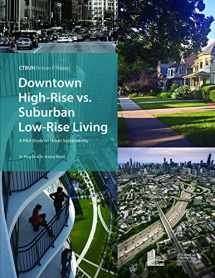
Downtown High-Rise vs. Suburban Low-Rise Living: A Pilot Study on Urban Sustainability
Book details
Summary
Description
It is widely assumed that the dense vertical city is more sustainable than the dispersed horizontal city. This concept has certainly been a large factor in the unprecedented increase in the construction of tall buildings globally over the last two decades, especially in the developing world. The concentration of people in denser cities sharing space, infrastructure, and facilities is typically thought to offer much greater energy efficiency than the expanded horizontal city, which requires more land use, as well as a higher energy expenditure in infrastructure and mobility.
Though this belief in the sustainability benefits of dense versus dispersed living is driving the development of cities from Toronto to Tianjin and from Sau Paulo to Shanghai, the principle has rarely been examined at a detailed, quantitative level. Studies to date have been mostly based on large data sets of generalized data regarding whole-urban energy consumption, or large-scale transport patterns. In some cases, seminal studies are still informing policy that is now several decades out of date. For instance, a study of 32 cities by Newman & Kenworthy in 1989 concluded that there was a strong link between urban development densities and petroleum consumption (Newman & Kenworthy, 1989). This study is still commonly cited, despite being 28 years old. Crucially, there are very few studies that also take into account a quality of life aspect to urban vs. suburban living, in addition to differences in energy use patterns.
Chicago, the city in which this research has taken place, is uniquely positioned for a study exploring density vs. sprawl from a sustainability point of view. The birthplace of the tall building and the main crucible for experimentation in the typology in the century or more since then, Chicago also has an ever-growing suburban area that is typical of most US cities. And yet, again in line with many other cities around the world over the past decade or two, it has seen suburban growth alongside densification of its downtown area and a resurgence of people seeking high-rise urban living.
This research report offers a quantitative evaluation of long-held assumptions, and with sometimes surprising results. The ground-breaking study quantitatively investigates and compares the sustainability of people s lifestyles in both urban and suburban areas from environmental and social perspectives, using actual energy bills collected from households, as well as other direct research methods. It fills significant research gaps in our knowledge of the sustainability of urban density compared to suburban sprawl, in terms of both environmental and social sustainability. This is an indispensable resource for urban planners, architects, utilities, developers, and anyone else with a stake in shaping the future of the built environment.


We would LOVE it if you could help us and other readers by reviewing the book
Book review



